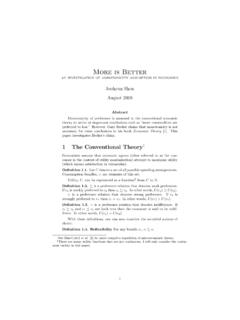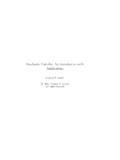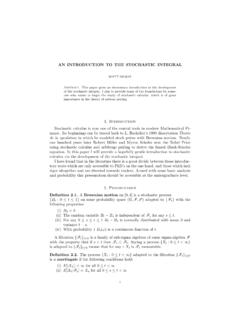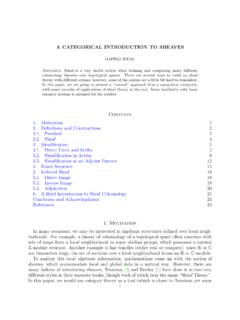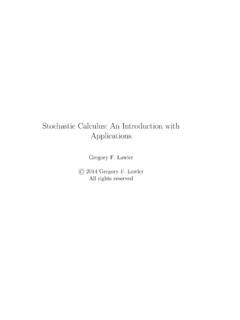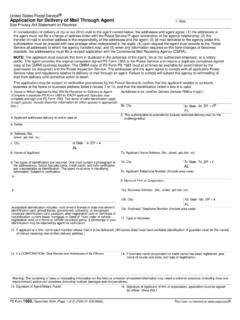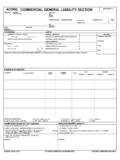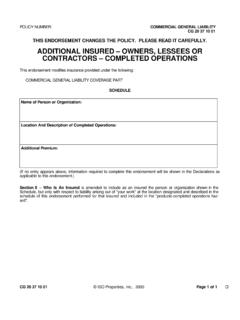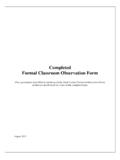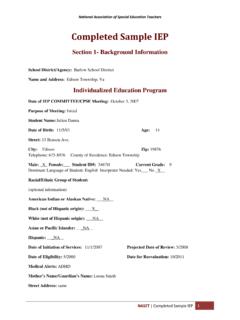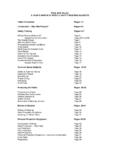Transcription of Completed cohomology – a survey
1 1 Completed cohomology a surveyFrank Calegari and Matthew EmertonThis note summarizes the theory ofp-adically Completed construction was first introduced in paper [8] (although insufficientattention was given there to the integral aspects of the theory), andthen further developed in the papers [4] and [12]. The papers [8] and [4]may give the impression thatp-adically Completed cohomology is somesort of auxiliary construction that can be used to prove theorems (ofeither ap-adic or classical nature) about automorphic forms. However,we believe thatp-adically Completed cohomology is in fact an object offundamental importance, and that it provides the best approximationthat we know of to spaces of p-adic automorphic forms.
2 (In particular,unlike the spaces that go by this name that are sometimes constructed byarithmetico-geometric means in the theory of modular curves, or moregenerally Shimura varieties,p-adically Completed cohomology admits arepresentation of thep-adic group, and thus allows the introduction ofrepresentation-theoretic methods into the study ofp-adic properties ofautomorphic forms.)A systematic exposition of the theory, and of its (largely conjectural,at this point) applications to thep-adic aspects of the Langlands corre-spondence between automorphic eigenforms and Galois representations,will be given in the paper [6]. These notes provide a summary of someof the basic points of the theory, as well as one of the main conjecturesof [6] (Conjecture below).
3 The anticipated connection of the theorywith thep-adic aspects of the Langlands program are discussed in thefinal Section We don t attempt to formulate any formal conjecturesin this section, but simply try to indicate, in very general and somewhatidealized terms, what form we expect this connection to take. Our maingoal for doing so here is to explain some the motivations behind making2 Calegari and EmertonConjecture It remains to be seen how closely our expectations, andour conjecture, conform to the reality of the DefinitionsLetG0be a pro-finite group, assumed to admit a countable basis ofneighbourhoods of the identity, consisting of normal open subgroups,say Gr G1 given a tower of topological spaces Xr X1 X0,each equipped with an action ofG0, such that:1.
4 The mapsXr+1 trivially onXr, and realizesXras aG0/Gr-torsor overX0.(In particular, all the maps in the tower are finite coverings.)In this context we may define thep-adically Completed homology andcohomology modules attached to the towerX (having fixed the primep), namely: H := lim rH (Xr,Zp)and H := lim slim rH (Xr,Z/psZ).We can also consider Borel Moore and compactly supported variants: HBM := lim rHBM (Xr,Zp)and H c:= lim slim rH c(Xr,Z/psZ).There are natural maps H HBM and H c H .From now on we suppose that eachXris a manifold which is ho-motopic to a finite simplicial complex. This ensures us that all the ho-mology spaces (usual or Borel Moore) and cohomology spaces (usual orCompleted cohomology a survey3compactly supported) ofXrthat we have written down are finitely gen-erated over the indicated ring of coefficients, and that they are relatedby appropriate forms of also suppose from now on thatG0is ap-adic analytic this hypothesis, it seems impossible to control the inverse limitsinvolved in our constructions.
5 On the other hand, with this hypothesis,one can control these limits in a very satisfactory way. Indeed, Lazard[14] has proved that Completed group ringZp[[G0]] is Noetherian, andSchneider and Teitelbaum [16] have explained how this result can beapplied to control various analytic difficulties that arise in the study ofp-adic Banach-space representations particular, we have the following result (which strengthens the re-sults stated in [8], in so far as it deals explicitly with homology as well ascohomology, and pays attention to the integral aspects of the construc-tions, and not just to the objects obtained after tensoring up withQp),whose proof will appear in [6].Theorem The natural action ofZp[[G0]]on the modules H and HBM makes each of them a finitely generated left module overZp[[G0]].
6 Furthermore, the canonical topology on each of these mod-ules(obtained by writing it as a quotient of a finite direct sum ofcopies ofZp[[G0]])coincides with projective limit that this implies in particular that each of the torsion submod-ules H [p ]and HBM [p ]is finitely generated overZp[[G0]], and soin particular, is of bounded The spaces H and H carep-adically complete and theirp-powertorsion submodules have bounded There are short exact sequences0 Homcont( H 1,Qp/Zp) H Homcont( H ,Zp) 0(herecontmeans continuous with respect to the canonical topology onthe source, and the evident topology either discrete orp-adic on the target)and0 Hom( H +1[p ],Qp/Zp) H Hom( H ,Zp) 0(since the natural topology on H is thep-adic topology, and sinceallZp-linear maps are automaticallyp-adically continuous, there is1 The paper [12] provides a sheaf-theoretic description of H and H c, which allowsfor more flexibility in the basic set-up of the theory than we permit , we will have no need for this extra generality in the applications thatwe have in and Emertonno need to explicitly specify any continuity conditions on the mapsappearing in this exact sequence), as well as similar short exact se-quences relating HBM and H c.
7 These exact sequences are compatiblewith the maps H HBM , and the maps H c H .4. For eachr 0,there are Hochschild Serre type spectral sequencesEi,j2:=Hi(Gr, Hj) = Hi+j(Xr,Zp)andEi,j2:=Hi(Gr, Hjc) = Hi+jc(Xr,Zp),compatible with the maps H c H .Remark any continuousG0-module overZp, then we mayassociate a family of local systemsM on the towerX toM, and thereis an analogue of part (4) of the theorem for the cohomology of the theorem shows the advantages of working with bothhomology and cohomology . It is on the homology side that the algebraicaspects of the theory are most transparent, while the cohomology sideis better adapted to comparison with the situation at finite is useful to make some additional definitions on the cohomologyside, as follows: H := thep-adic completion of lim rH (Xr,Zp)= lim s(lim rH (Xr,Zp)/psH (Xr,Zp))andTpH := thep-adic Tate module of lim rH (Xr,Zp)= lim slim rH (Xr,Zp)[ps](the transition maps being given by multiplication byp).
8 Note thatthep-adic completion kills thep-divisible part of lim rH (Xr,Zp),whilethep-adic Tate module knows only about the torsion subgroup of thisdivisible part. There is an exact sequence0 H H TpH +1 0.( ) Completed cohomology a survey5 SinceTpH +1isp-torsion-free andp-adically complete, we may take theZpdual of this exact sequence to obtain a short exact sequence0 Hom(TpH +1,Zp) Hom( H ,Zp) Hom( H ,Zp) from Theorem (3) that Hom( H ,Zp) is thep-torsion freequotient of H .There are similar constructions for compactly supported cohomology ,and their formation is compatible with the maps H c H . Non-commutative Iwasawa theoryIfMis any finitely generated leftZp[[G0]]-module, then we defineE (M) := Ext (M,Zp[[G0]]).
9 These are again naturallyZp[[G0]]-modules. (We compute the Exts viathe leftZp[[G0]]-module structure onZp[[G0]], leaving a rightZp[[G0]]-module structure onE (M). We convert this back to a left-module struc-ture via the canonical anti-involution ofZp[[G0]] induced byg7 g 1.)We note that these modules are unchanged (up to a natural isomorphism,and applying the forgetful functor fromZp[[G0]]-modules toZp[[G 0]]-modules) if we replaceG0by any open subgroupG define thecodimensionofM(or codimMfor short) to be theminimal value ofisuch thatEi(M)6= commutative, then thisagrees with the usual notion of codimension of support of the coherentsheaf associated toMon SpecZp[[G0]]. In general, even ifG0is non-commutative (which is typically the case), this notion behaves entirelyanalogously to the usual notion of codimension of support of a sheafin algebraic geometry [18].
10 In addition to the codimension ofM, it issometimes convenient to speak of thedimensionofM(or theIwasawadimensionofM, for emphasis), which we define to be the quantity 1 +dimG0 codimM. (If we think of codimMas being the codimension ofthe support of the in general non-existent coherent sheaf associatedtoMon the in general non-existent Spec ofZp[[G0]], then theIwasawa dimension ofMwould be the dimension of its support.)We also remark that if we shrinkG0sufficiently ( replaceG0byGrfor a large enough value ofr), thenZp[[G0]] admits a skew-field offractions, sayL, and hence we can speak of a finitely generatedZp[[G0]]-moduleMbeing torsion-free (the natural mapM L Mis injective)6 Calegari and Emertonor torsion (L M= 0), and we can speak of the rank of the (torsion-free part of)M( the rank of theL-vector spaceL M).
